The office is now closed until 10am on Tuesday January 3rd 2012.
A very merry Christmas and a happy new year to all of our customers, suppliers and friends.
If you have a web site hosted with us and there is an emergency over the holiday period, please telephone or email in the usual way.
Friday, 23 December 2011
Thursday, 20 October 2011
Strong Email Passwords - New Rules from this Saturday

If you log on to helm.cfmxhosting.co.uk to manage your email accounts, then this post is for you.
From this Saturday, the rules for password security are changing on your mail server.
Why?
Because in the past some users of the mail server have created very weak passwords.
Why you should care
Because this has allowed malicious users to crack those accounts and use the server to send spam. This affects everyone who shares the server because it can result in the server being blacklisted, impacting on the reputation of the server and all its legitimate users.
What is changing?
1) Starting from Saturday, October 22nd 2011, it will be impossible to create a new mailbox or update the password for an existing mailbox without choosing a "strong" password
2) For complete security of your account, it is recommended that you change any existing passwords so they are "strong"
What do you mean by "strong"?
I'm glad you asked. A "strong" password must meet all five of the following criteria:
a) minimum 8 characters
b) at least 1 number
c) upper *and* lower case letters
d) at least 1 non-alpha-numeric character such as !ӣ$%^&*()_=+,.<>/?)
e) cannot be the same as username
If you do not update the password on your existing accounts, you should still be able to send and receive email as usual, but it is highly recommended that you choose a better password. If you use the SmarterMail web interface to access your email (and I know very few of you do) then you will be prompted to change your password next time you log in if it does not meet the criteria above.


GOOD PASSWORDS
!G1MME s0me SUG4R babY!
*Tr3a5ur3 1S1anD*
C£shier No.9, P13ase
BAD PASSWORDS
password
1234
R1chard
To add and edit email accounts, use this website: helm.cfmxhosting.co.uk and enter your username and password when prompted.
Monday, 3 October 2011
Duplicating a Page with Concrete5
The most obvious way to create a new page with Concrete5 is by clicking the "Add Page" button - but there is another way.
Sometimes creating a duplicate of another page is the easiest way to add a new page. This video explains how - and as always with Concrete5, it's very simple.
Thursday, 18 August 2011
New Look For Google Sitelinks
Google has made some changes to its sitelinks to make results more extensive and more prominent than ever before.
Even if you're not aware of Google's term "sitelinks", you've almost certainly seen them before. From a search engine optimisation point of view, they're not all that important. You won't see sitelinks if you search for a generic term, like "boilers" or "engines" or "carpet cleaning", but you will see them if you search for a specific company name, like "MTV", "Amazon" or "Microsoft" - where Google is more than 99% sure that it's found the best possible site to match your query, it gives you a miniature index of that site in two columns below the main homepage listing.
As of this week, that index has become a lot less miniature. In terms of sheer screen area, the sitelinks section for the Sherpa Van website (see below) has tripled from about 150 pixels in height to around 470 pixels.
So it's bigger, but is it better?
Well, not really. Again, in this example you'll see that some of the links that have been added are really not what you'd call top-level pages. There are literally hundreds of towns and villages in the Sherpa Van database and for some unknown reason Google has picked out links to three of them: "Shap", "Malham" and "Hethpool". These places are no more important than any of the others and indeed they're far less important than many. And you get a slightly different set of results if you alter the search terms slightly (for instance, "sherpa van" gets a different set of sitelinks to "the sherpa van project").
Fortunately, Google obviously recognises that some of the automated sitelinks are not going to be very useful, so it's given us the necessary tool to remove or "demote" unwanted links via Webmaster Tools.
So I have dived in and demoted Shap from the listings. Assuming you already know your way around Webmaster Tools (if you don't - call me) you just go to the Sitelinks page for your site and paste in the URL you want to remove:

The URL then gets added to a list of up to 100:

What does all this tell us?
If you're lucky enough to have people searching for your company or brand name, it's a massive enhancement to your top-of-the-page Google listing. If, like most of us, your customers are more likely to be searching for what you do rather than who you are, then you'll never notice the difference.
Examples:
Here's a screengrab I took back on June 22nd this year:

And here's what you get if you do the same search today:
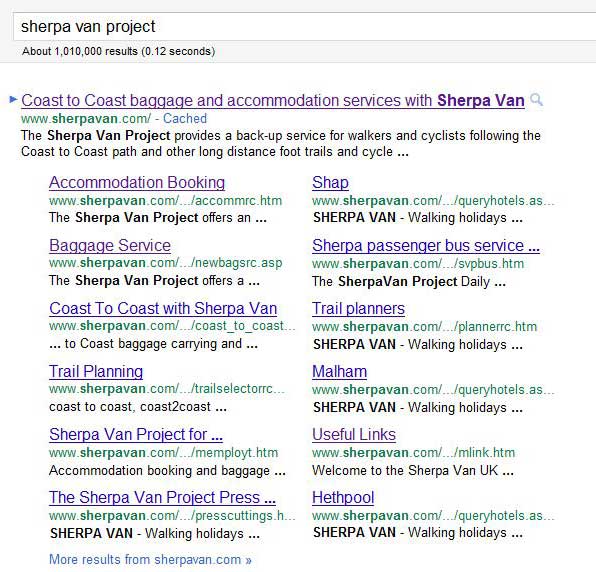
And just out of interest, here's what the inframes.com sitelinks look like today:

Even if you're not aware of Google's term "sitelinks", you've almost certainly seen them before. From a search engine optimisation point of view, they're not all that important. You won't see sitelinks if you search for a generic term, like "boilers" or "engines" or "carpet cleaning", but you will see them if you search for a specific company name, like "MTV", "Amazon" or "Microsoft" - where Google is more than 99% sure that it's found the best possible site to match your query, it gives you a miniature index of that site in two columns below the main homepage listing.
As of this week, that index has become a lot less miniature. In terms of sheer screen area, the sitelinks section for the Sherpa Van website (see below) has tripled from about 150 pixels in height to around 470 pixels.
So it's bigger, but is it better?
Well, not really. Again, in this example you'll see that some of the links that have been added are really not what you'd call top-level pages. There are literally hundreds of towns and villages in the Sherpa Van database and for some unknown reason Google has picked out links to three of them: "Shap", "Malham" and "Hethpool". These places are no more important than any of the others and indeed they're far less important than many. And you get a slightly different set of results if you alter the search terms slightly (for instance, "sherpa van" gets a different set of sitelinks to "the sherpa van project").
Fortunately, Google obviously recognises that some of the automated sitelinks are not going to be very useful, so it's given us the necessary tool to remove or "demote" unwanted links via Webmaster Tools.
So I have dived in and demoted Shap from the listings. Assuming you already know your way around Webmaster Tools (if you don't - call me) you just go to the Sitelinks page for your site and paste in the URL you want to remove:

The URL then gets added to a list of up to 100:

What does all this tell us?
If you're lucky enough to have people searching for your company or brand name, it's a massive enhancement to your top-of-the-page Google listing. If, like most of us, your customers are more likely to be searching for what you do rather than who you are, then you'll never notice the difference.
Examples:
Here's a screengrab I took back on June 22nd this year:

And here's what you get if you do the same search today:

And just out of interest, here's what the inframes.com sitelinks look like today:

Monday, 1 August 2011
Executive Guide to DNS
The first thing you need to understand about DNS is that for every website there is a registrar, a set of "nameservers", DNS records and a host. In some cases, these things can be provided by several different companies.
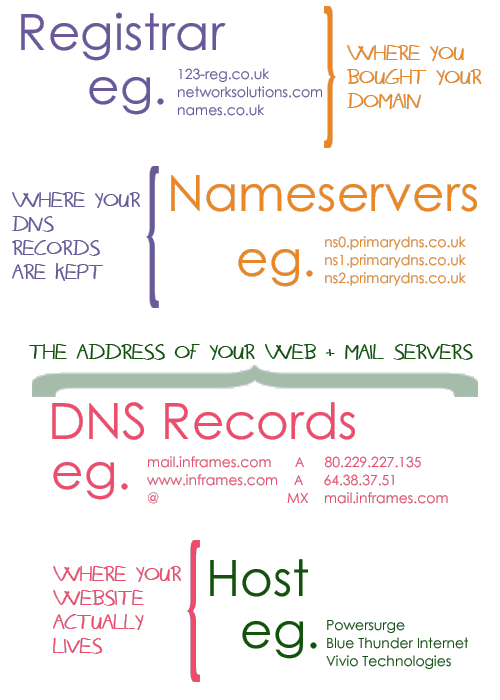
The registrar sells you the domain.
The nameservers are the authoritative source of your DNS records.
DNS records tell anyone who wants to know that your website is in one place and your mail server is in another. It's like an address book of IP addresses.
The host is where your website, email and any other internet services actually live. And again, you can have email and web hosted in different places.
When you register a new domain, the registrar will set the nameservers to its own. For example, if you buy a domain from 123-reg, you'll find the nameservers are ns.123-reg.co.uk and ns2.123-reg.co.uk.
You can then change these to different nameservers, either (in the case of 123-reg) using a web-based control panel they provide or by just contacting a customer services representative - it varies from one company to another. A registrar should never charge you for changing your nameservers.
The same applies for the individual DNS records. You can often control them yourself or in some cases you'll have to call or email tech support. If you find that it's difficult to make these sort of changes, then you should consider finding a more flexible and helpful company to handle your web hosting (hint, hint).

The registrar sells you the domain.
The nameservers are the authoritative source of your DNS records.
DNS records tell anyone who wants to know that your website is in one place and your mail server is in another. It's like an address book of IP addresses.
The host is where your website, email and any other internet services actually live. And again, you can have email and web hosted in different places.
When you register a new domain, the registrar will set the nameservers to its own. For example, if you buy a domain from 123-reg, you'll find the nameservers are ns.123-reg.co.uk and ns2.123-reg.co.uk.
You can then change these to different nameservers, either (in the case of 123-reg) using a web-based control panel they provide or by just contacting a customer services representative - it varies from one company to another. A registrar should never charge you for changing your nameservers.
The same applies for the individual DNS records. You can often control them yourself or in some cases you'll have to call or email tech support. If you find that it's difficult to make these sort of changes, then you should consider finding a more flexible and helpful company to handle your web hosting (hint, hint).
Wednesday, 6 July 2011
Transfer Your Domain Free of Charge
If you already have a .co.uk domain name bought and paid for, you can transfer it to 123-reg.co.uk free of charge and use the DNS management tools to point it at our nameservers.
Just go to the site and choose the "Transfer" option from the "Domain names" menu:
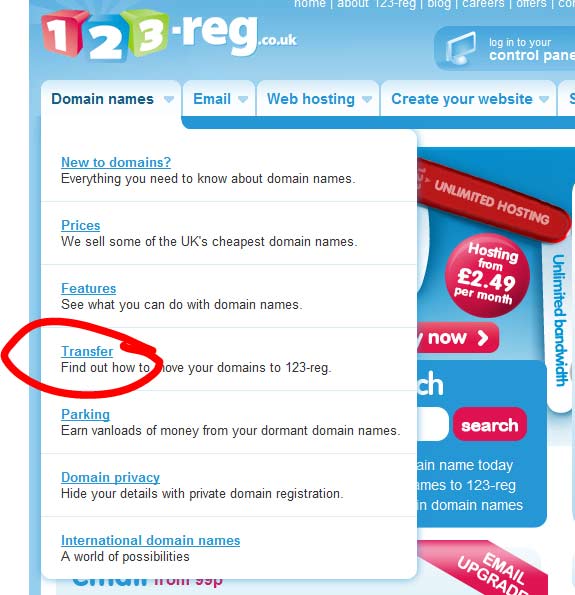
If you want to transfer a .com domain, that currently costs £9.99
You might want to have a look at their Domain Transfer Checklist page before you get started. There are different rules for .uk domains and for .com domains (dotcom domains are referred to as TLDs or top-level domains). In a nutshell, for .uk domains you need to ask your existing registrar to change the IPSTAG and for TLDs you need to ask your existing registrar to unlock the domain.
Once you've transferred your domain to 123-reg, you can use their web-based admin system to update the nameservers.
Our nameservers are:
ns0.primarydns.co.uk - 62.197.34.110
ns1.primarydns.co.uk - 62.197.35.33
ns2.primarydns.co.uk - 69.162.127.106
Just go to the site and choose the "Transfer" option from the "Domain names" menu:

If you want to transfer a .com domain, that currently costs £9.99
You might want to have a look at their Domain Transfer Checklist page before you get started. There are different rules for .uk domains and for .com domains (dotcom domains are referred to as TLDs or top-level domains). In a nutshell, for .uk domains you need to ask your existing registrar to change the IPSTAG and for TLDs you need to ask your existing registrar to unlock the domain.
Once you've transferred your domain to 123-reg, you can use their web-based admin system to update the nameservers.
Our nameservers are:
ns0.primarydns.co.uk - 62.197.34.110
ns1.primarydns.co.uk - 62.197.35.33
ns2.primarydns.co.uk - 69.162.127.106
Tuesday, 28 June 2011
Quirk Converting Coldfusion to Railo
This is a neat and useful bit of code I've been using for about a decade to handle the output from a form in Coldfusion:
Within the loop, I usually do something like this to check for a particular field name so that I can do error-checking or something:
In Coldfusion, the value of form.fieldnames would always be in capitals, even if the original HTML form had all the field names in lower case.
But since I've started working with Railo, I've found that this doesn't work the same. The loop works, but Railo doesn't recognise "FIRST_NAME" if the HTML on the page was written as "first_name".
So, if you want to check for a particular field name without knowing for sure if the original field name was written in upper or lower case, you have to do something like this...
On balance, I'd say Railo works the way you'd expect. Better men than me probably know why Coldfusion has always converted fieldnames to caps. Before you start writing - I don't really need to know.
<CFLOOP FROM="1" TO="#ListLen(form.fieldnames)#" INDEX="y">
#ListGetAt(form.fieldnames,y)# = #Evaluate(ListGetAt(form.fieldnames,y))#<br />
</CFLOOP>
Within the loop, I usually do something like this to check for a particular field name so that I can do error-checking or something:
<cfif find("FIRST_NAME", #ListGetAt(form.fieldnames,y)#) gt 0>
... some code ...
</cfif>
In Coldfusion, the value of form.fieldnames would always be in capitals, even if the original HTML form had all the field names in lower case.
But since I've started working with Railo, I've found that this doesn't work the same. The loop works, but Railo doesn't recognise "FIRST_NAME" if the HTML on the page was written as "first_name".
So, if you want to check for a particular field name without knowing for sure if the original field name was written in upper or lower case, you have to do something like this...
<cfif find("FIRST_NAME", #ListGetAt(UCASE(form.fieldnames),y)#) gt 0>
... some code ...
</cfif>
On balance, I'd say Railo works the way you'd expect. Better men than me probably know why Coldfusion has always converted fieldnames to caps. Before you start writing - I don't really need to know.
Friday, 20 May 2011
Importing Contacts to SmarterMail
Yes, you can import data into SmarterMail from other email software!
Here's how you import a list of contacts:
1. Log in using the credentials provided.
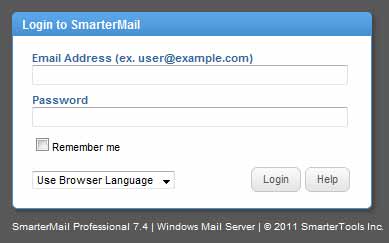
2. Click the Contacts icon
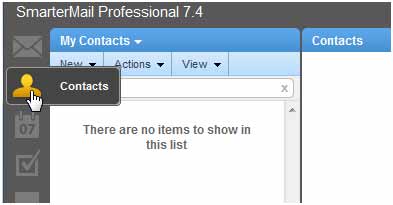
3. From the Actions menu choose Import/Export, then Import
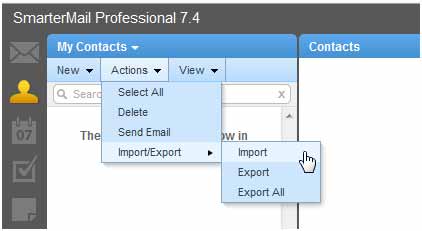
4. You'll see this "File to Upload" box:

5. Click "Browse" and locate your contacts file, which ought to be in CSV format
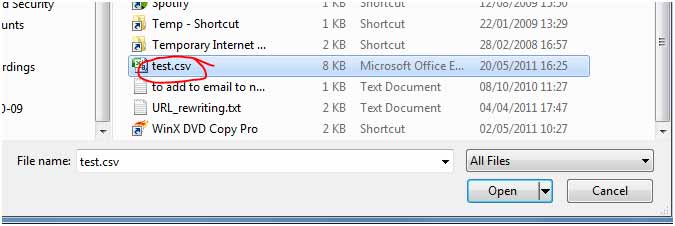
6. Click "Next"

7. You'll be prompted to match up the fields in your file to the fields in SmarterMail – you might want to select "ignore" for some of them as I've done here – then click "Next" again:
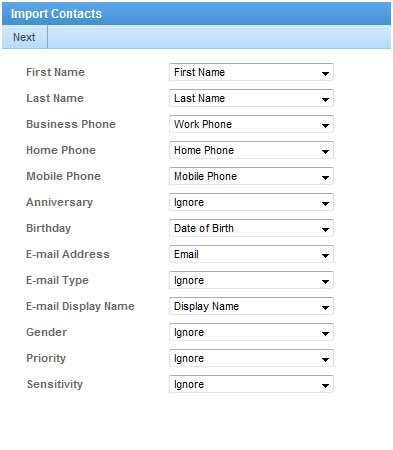
8. You might be prompted to clarify or "skip" one or two of the items in your list – otherwise, that's it, you've finished and the contacts will be imported in no time.
Here's how you import a list of contacts:
1. Log in using the credentials provided.

2. Click the Contacts icon

3. From the Actions menu choose Import/Export, then Import

4. You'll see this "File to Upload" box:

5. Click "Browse" and locate your contacts file, which ought to be in CSV format

6. Click "Next"

7. You'll be prompted to match up the fields in your file to the fields in SmarterMail – you might want to select "ignore" for some of them as I've done here – then click "Next" again:

8. You might be prompted to clarify or "skip" one or two of the items in your list – otherwise, that's it, you've finished and the contacts will be imported in no time.
Wednesday, 11 May 2011
BNI 60 Seconds - New Law on Cookies

Each week in our BNI lunchtime meeting, I am expected to get up and tell other members and visitors a little bit about my work in a sixty second snapshot.
If you want to find out a bit more about our weekly meetings, skip to the bottom of this page.
Here's what I had to say this week:
"My name is Jon Ewing and I help people to have the best possible shop window on the street where the world does its shopping – the internet.
"My company is called inframes and we have been making websites for eleven years, and the vast majority of those sites have used - in one way or another - cookies, little hidden text files that a website uses to store information on your computer or mobile device.
"This week I just wanted to mention a change to the law on the use of cookies by websites which will affect a lot of companies. From May 26th, as a result of a change to the European Telecommunication Directive, websites will be legally obliged to ask for a user’s consent if they want to store a cookie on that user’s device.
The government expects all companies to have at the very least what they call “a realistic plan to achieve compliance”. You can find out more by visiting the Information Commissioner’s Office website at ico.gov.uk or just give me a call and I can tell you whether your site is going to be affected.
"To find out how good your website could be, look into inframes."
What's BNI?
I am part of a growing new chapter of the BNI business networking group and we're looking for other Reading-based small business professionals to refer business to.
We meet between 12.15pm and 1.45pm on Wednesdays. If you'd like to come along to a lunch, please drop me a line or give me a call and I'll put you in touch with our organiser.
There's absolutely no commitment required – you just pay a tenner, which covers the cost of lunch at the Strada on the Oracle Riverside - and you'll have a chance to meet existing members and other visitors, introduce your business and of course hand out business cards.
Monday, 2 May 2011
First Steps in Setting Up Your Own Website Forum
Forums and bulletin boards have been around since the very early days of the internet and there a lot of different ways to create or manage your own.
Free and Open Source
You could use a free service like invisionfree.com where it's all hosted for you.
If you want to host it yourself, consider open source software, like phpbb.com (probably the most popular of all the open source forums – see reading-forum.co.uk).
Also look at simplemachines.org and phpnuke.org and jforum.net and on and on – there are literally dozens of them. So really it's a case of deciding you want from the forum and which product suits you best.
Commercial Software Packages
Start by looking at vBulletin. That's about $195. The Digital Point forum that I use sometimes is run with vBulletin. Or something like ASP Playground which is about $300.
I have used UBB Threads for one of my clients, which is very good and costs $139, but isn't hugely customisable, visually-speaking.
Obviously, if you're not a developer yourself, the cost of setting up one of these sites will combine the cost of the software (from zero upwards), plus the amount of time it takes to install, plus a degree of customisation, plus a degree of integration with the rest of your website.
Free and Open Source
You could use a free service like invisionfree.com where it's all hosted for you.
If you want to host it yourself, consider open source software, like phpbb.com (probably the most popular of all the open source forums – see reading-forum.co.uk).
Also look at simplemachines.org and phpnuke.org and jforum.net and on and on – there are literally dozens of them. So really it's a case of deciding you want from the forum and which product suits you best.
Commercial Software Packages
Start by looking at vBulletin. That's about $195. The Digital Point forum that I use sometimes is run with vBulletin. Or something like ASP Playground which is about $300.
I have used UBB Threads for one of my clients, which is very good and costs $139, but isn't hugely customisable, visually-speaking.
Obviously, if you're not a developer yourself, the cost of setting up one of these sites will combine the cost of the software (from zero upwards), plus the amount of time it takes to install, plus a degree of customisation, plus a degree of integration with the rest of your website.
Monday, 7 March 2011
cfajaximport 'Coldfusion' is not defined error
A tip for anyone who's getting a "'Coldfusion' is not defined" error on Coldfusion 8/9 when using cfajaximport: check your virtual directories.
I spent some time this morning trying to work this one out but it was a simple solution in the end.
What was confusing me was that I could view the source of my CFML file in Firefox...

...and when I clicked on the script links, I could access the corresponding code...

Yet somehow the Javascript wasn't working.
The solution was simple - although the CFIDE virtual directory was mapped correctly in Coldfusion Administrator...

...there was not an equivalent in IIS.
I added the virtual directory to IIS and now Bob is my proverbial uncle - cfajaximport works just fine.

I'm not an expert on Apache/Tomcat etc but I suspect the same issue crops up on that platform and can be fixed similarly easily.
I spent some time this morning trying to work this one out but it was a simple solution in the end.
What was confusing me was that I could view the source of my CFML file in Firefox...

...and when I clicked on the script links, I could access the corresponding code...

Yet somehow the Javascript wasn't working.
The solution was simple - although the CFIDE virtual directory was mapped correctly in Coldfusion Administrator...

...there was not an equivalent in IIS.
I added the virtual directory to IIS and now Bob is my proverbial uncle - cfajaximport works just fine.

I'm not an expert on Apache/Tomcat etc but I suspect the same issue crops up on that platform and can be fixed similarly easily.
Tuesday, 1 February 2011
10 Ways to Make Money from your Website
1. First and foremost, does the site target the market directly? Some businesses don't have a clue who their market even is. People who say "well, you know, just anybody" are lucky to be in business at all, quite frankly, but it's amazing how common that is. If you already have a website, compare it to competitors in the same market and see if it's in keeping with what the customer is likely to have seen elsewhere in terms of tone and content. To put it another way, do you have an appropriate brand and is your branding carried out consistently?
2. Is there a call to action? A lot of websites or marketing materials promote products and services but don't close the sale. Any business can change that – even if they don't take money directly on their website – but turning an opportunity into a transaction or a lead. With a bit of imagination, you can give the customer a reason to act right now, today, rather than tomorrow, next week, sometime or (inevitably in some cases) never.
3. Is the site actively promoted to existing offline customers? How much are existing customers aware of what products or services are on offer? It's amazing how often small businesses assume their customers know everything about them. And yet that's rarely true. People are wont to make assumptions about their suppliers. Communication might be done through opt-in email mailing list, RSS newsfeed, or possibly by Facebook or Twitter.
4. Is the site up to date? Google likes to see a website that's fresh and relevant; sites that haven't been updated in three years will suffer in their rankings as a result. If your site was updated this morning, it shows that you're actively working on your business. That, in turn, gives the consumer confidence that your organisation is busy and thriving. You may think you're too busy to update your site, or that nothing has really changed since last month, but other people won't know that – all they know is that it never changes.
5. Does the site have a product that can be sold on eBay? eBay is the world's biggest marketplace and provides a very sophisticated back-end interface for turning your stock into product pages – once you've got all your ducks in a row, it's just a matter of uploading an Excel spreadsheet. And there are other marketplaces available like Amazon or Auto Trader, depending on the market sector.
6. Does the business serve a particular town or region? If so, Google Places is a must – completely free to sign up for and within a few hours you could find your business catapulted to the top of the Google rankings for your chosen keywords. But only for your hometown, of course.
7. Has affiliate marketing been considered? Affiliate Window, Affiliate Future, Webgains, Tradedoubler, Silverbean, Buyat, Paid on Results, Zanox, OMG, Affilinet, Clickbank, Commission Junction... there are probably others that I've never even heard of. They're a great way to get other people promoting your products or services, especially if you've got a high enough margin to offer really good commissions.
8. Does the site have a high volume of traffic? Google Adsense could be a potential revenue stream.
9. Do you have a great homepage? A homepage is like your shop window. And a good shop window will encourage customers to come inside the shop. That's all. You just want to get them over the threshold and you've won half the battle. You should use the homepage to showcase your company's most impressive features – your own unique "wow factor", whatever that might be. Don't go into detail – just get the customer into the shop. After that you can go into greater depth if that's what it takes to make the sale.
10. Have you got a programme of search engine optimisation? This is a can of worms to be opening, which is why I've left it till last. SEO could easily be a full-time job for any business. And yet there are a handful of simple rules that can be carried out in a very short time that really make a noticeable difference to any site's Google ranking.
Jon Ewing
2. Is there a call to action? A lot of websites or marketing materials promote products and services but don't close the sale. Any business can change that – even if they don't take money directly on their website – but turning an opportunity into a transaction or a lead. With a bit of imagination, you can give the customer a reason to act right now, today, rather than tomorrow, next week, sometime or (inevitably in some cases) never.
3. Is the site actively promoted to existing offline customers? How much are existing customers aware of what products or services are on offer? It's amazing how often small businesses assume their customers know everything about them. And yet that's rarely true. People are wont to make assumptions about their suppliers. Communication might be done through opt-in email mailing list, RSS newsfeed, or possibly by Facebook or Twitter.
4. Is the site up to date? Google likes to see a website that's fresh and relevant; sites that haven't been updated in three years will suffer in their rankings as a result. If your site was updated this morning, it shows that you're actively working on your business. That, in turn, gives the consumer confidence that your organisation is busy and thriving. You may think you're too busy to update your site, or that nothing has really changed since last month, but other people won't know that – all they know is that it never changes.
5. Does the site have a product that can be sold on eBay? eBay is the world's biggest marketplace and provides a very sophisticated back-end interface for turning your stock into product pages – once you've got all your ducks in a row, it's just a matter of uploading an Excel spreadsheet. And there are other marketplaces available like Amazon or Auto Trader, depending on the market sector.
6. Does the business serve a particular town or region? If so, Google Places is a must – completely free to sign up for and within a few hours you could find your business catapulted to the top of the Google rankings for your chosen keywords. But only for your hometown, of course.
7. Has affiliate marketing been considered? Affiliate Window, Affiliate Future, Webgains, Tradedoubler, Silverbean, Buyat, Paid on Results, Zanox, OMG, Affilinet, Clickbank, Commission Junction... there are probably others that I've never even heard of. They're a great way to get other people promoting your products or services, especially if you've got a high enough margin to offer really good commissions.
8. Does the site have a high volume of traffic? Google Adsense could be a potential revenue stream.
9. Do you have a great homepage? A homepage is like your shop window. And a good shop window will encourage customers to come inside the shop. That's all. You just want to get them over the threshold and you've won half the battle. You should use the homepage to showcase your company's most impressive features – your own unique "wow factor", whatever that might be. Don't go into detail – just get the customer into the shop. After that you can go into greater depth if that's what it takes to make the sale.
10. Have you got a programme of search engine optimisation? This is a can of worms to be opening, which is why I've left it till last. SEO could easily be a full-time job for any business. And yet there are a handful of simple rules that can be carried out in a very short time that really make a noticeable difference to any site's Google ranking.
Jon Ewing
Wednesday, 12 January 2011
inframes To The Rescue

Each week in our BNI lunchtime meeting, I am expected to get up and tell other members and visitors a little bit about my work in a sixty second snapshot.
If you want to find out a bit more about our weekly meetings, skip to the bottom of this page.
Here's what I had to say this week:
"My name is Jon Ewing and I help companies to have the best possible storefront on the street where the world does its windows shopping – the internet.
"My company, inframes.com ltd, has been making websites for over 11 years and you should refer business to me because we use the internet to help companies open up new markets.
"This week we’ve been working a lot with Sherpa Walking Holidays, who are currently in their busiest sales period as people all over the world book their summer holidays.
"We had a very unusual problem at the beginning of the month with a site they own that sells maps and guidebooks.
"The shopping basket system suddenly stopped working, so no orders were coming in. The code for the shopping basket was written more than a decade ago by a third party who long ago went out of business.
"Finally we got to the bottom of it. And I guess the people who wrote that code never thought it would still be in use in 2011 because it turned out that there was an expiry date hard-coded into the system making all transactions automatically expire on December 31 2010. So as of January 1 2011, every transaction expired before it had begun.
"Fortunately we were able to fix that problem immediately we’d diagnosed it.
"So a good referral for me would be someone who’s having trouble with a website that was built long ago by a defunct company and needs someone to step in and get it working.
"To find out how good your website could be, look into inframes."
What's BNI?
I am part of a growing new chapter of the BNI business networking group and we're looking for other Reading-based small business professionals to refer business to.
We meet between 12.15pm and 1.45pm on Wednesdays. If you'd like to come along to a lunch, please drop me a line or give me a call and I'll put you in touch with our organiser.
There's absolutely no commitment required – you just pay a tenner, which covers the cost of lunch at the Strada on the Oracle Riverside - and you'll have a chance to meet existing members and other visitors, introduce your business and of course hand out business cards.
Labels:
BNI
Subscribe to:
Posts (Atom)
